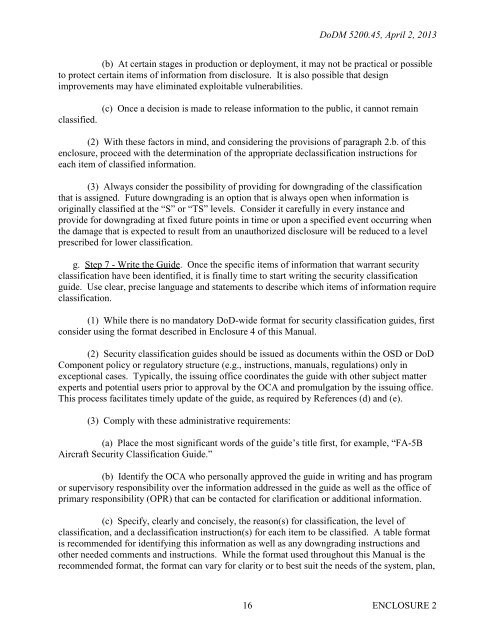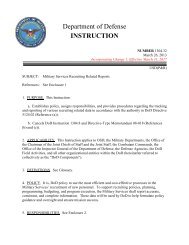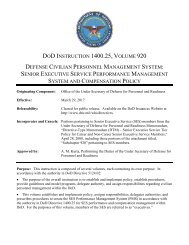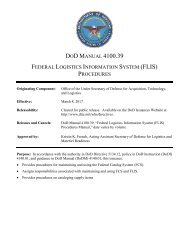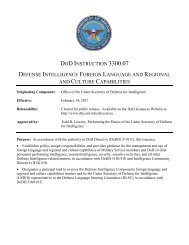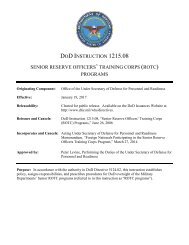520045m
520045m
520045m
You also want an ePaper? Increase the reach of your titles
YUMPU automatically turns print PDFs into web optimized ePapers that Google loves.
DoDM 5200.45, April 2, 2013<br />
(b) At certain stages in production or deployment, it may not be practical or possible<br />
to protect certain items of information from disclosure. It is also possible that design<br />
improvements may have eliminated exploitable vulnerabilities.<br />
classified.<br />
(c) Once a decision is made to release information to the public, it cannot remain<br />
(2) With these factors in mind, and considering the provisions of paragraph 2.b. of this<br />
enclosure, proceed with the determination of the appropriate declassification instructions for<br />
each item of classified information.<br />
(3) Always consider the possibility of providing for downgrading of the classification<br />
that is assigned. Future downgrading is an option that is always open when information is<br />
originally classified at the “S” or “TS” levels. Consider it carefully in every instance and<br />
provide for downgrading at fixed future points in time or upon a specified event occurring when<br />
the damage that is expected to result from an unauthorized disclosure will be reduced to a level<br />
prescribed for lower classification.<br />
g. Step 7 - Write the Guide. Once the specific items of information that warrant security<br />
classification have been identified, it is finally time to start writing the security classification<br />
guide. Use clear, precise language and statements to describe which items of information require<br />
classification.<br />
(1) While there is no mandatory DoD-wide format for security classification guides, first<br />
consider using the format described in Enclosure 4 of this Manual.<br />
(2) Security classification guides should be issued as documents within the OSD or DoD<br />
Component policy or regulatory structure (e.g., instructions, manuals, regulations) only in<br />
exceptional cases. Typically, the issuing office coordinates the guide with other subject matter<br />
experts and potential users prior to approval by the OCA and promulgation by the issuing office.<br />
This process facilitates timely update of the guide, as required by References (d) and (e).<br />
(3) Comply with these administrative requirements:<br />
(a) Place the most significant words of the guide’s title first, for example, “FA-5B<br />
Aircraft Security Classification Guide.”<br />
(b) Identify the OCA who personally approved the guide in writing and has program<br />
or supervisory responsibility over the information addressed in the guide as well as the office of<br />
primary responsibility (OPR) that can be contacted for clarification or additional information.<br />
(c) Specify, clearly and concisely, the reason(s) for classification, the level of<br />
classification, and a declassification instruction(s) for each item to be classified. A table format<br />
is recommended for identifying this information as well as any downgrading instructions and<br />
other needed comments and instructions. While the format used throughout this Manual is the<br />
recommended format, the format can vary for clarity or to best suit the needs of the system, plan,<br />
16<br />
ENCLOSURE 2


